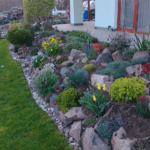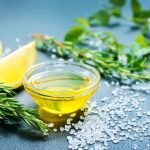Are you looking for inspiration on creating a beautiful and functional outdoor space? If so, then edible landscape design ideas may be just what you need. Edible landscaping combines the best of both worlds, providing an aesthetically pleasing garden while also offering the practicality of growing your own food. In this article, we will explore the concept of edible landscape design and its benefits, as well as provide tips and ideas to help you create your own edible garden oasis.
Edible landscape design is a growing trend that focuses on integrating food-producing plants into the traditional landscape. By incorporating fruits, vegetables, herbs, and edible flowers into your outdoor space, you can create a visually appealing garden that also provides a sustainable source of fresh produce. From small herb gardens to expansive fruit orchards, there are endless possibilities when it comes to designing an edible landscape.
In addition to the obvious benefit of having access to fresh, homegrown food, edible landscapes can also contribute to environmental sustainability by reducing the need for store-bought produce that may come with a heavy carbon footprint. Furthermore, incorporating edible plants into your yard can attract beneficial pollinators and wildlife, contributing to biodiversity.
Whether you have a sprawling backyard or a compact urban patio, there are plenty of options for incorporating edible plants into your landscape design. Read on as we delve deeper into this exciting concept and provide you with valuable tips and ideas for getting started with your own edible garden.
Planning Your Edible Landscape
Assess Your Space
Before diving into the design of your edible landscape, it’s important to assess your space. Take note of the amount of sunlight each area receives, the soil quality, and any potential obstacles such as trees or buildings. This will help you determine the best spots for planting different types of edible plants and structures.
Create Functional Zones
When planning your edible landscape, consider creating functional zones based on the types of edibles you want to grow. For example, designate an area for fruit trees, another for herbs and vegetables, and perhaps another for berry bushes. By creating these designated zones, you can maximize your space and make it easier to manage and maintain your garden.
Consider Access and Pathways
Incorporating pathways into your edible landscape is not only practical but also adds visual appeal. Think about how you will access different areas of your garden for planting, maintenance, and harvesting. Paths can be made from a variety of materials such as gravel, mulch, or even stepping stones. Planning for easy access will make caring for your garden much more enjoyable.
By carefully considering these tips when designing and laying out your edible garden, you can create a beautiful and productive space that provides a bountiful harvest while adding aesthetic value to your overall landscape.
Remember, it’s important to get creative with your edible landscape design ideas while also keeping functionality in mind.
Choosing the Right Plants
When it comes to creating an edible landscape, choosing the right plants is crucial. You want to select a variety of fruits, vegetables, and herbs that not only thrive in your climate but also complement each other aesthetically. Here are some popular edible plants suitable for landscaping and their maintenance requirements:
- Herbs: Herbs are a fantastic addition to any edible landscape. They are not only practical for cooking, but they also add texture, color, and fragrance to your garden. Some commonly used herbs for landscaping include rosemary, thyme, basil, and mint. These plants are relatively low maintenance and can thrive in both full sun and partial shade.
- Vegetables: Incorporating vegetables into your landscape design not only provides you with fresh produce but also adds visual interest. Consider planting tomatoes, peppers, cucumbers, and kale. These vegetables require regular watering and benefit from well-drained soil rich in organic matter.
- Fruit Trees: Fruit-bearing trees such as apple, pear, peach, and cherry trees can serve as the focal point of your edible landscape. These trees require adequate space as well as proper pruning and fertilization to ensure a bountiful harvest.
In addition to these plant options, consider including edible flowers such as nasturtiums or pansies for a pop of color in your garden. It’s important to research the specific requirements for each plant you choose to ensure they receive the proper care and maintenance.
When planning your edible landscape design ideas, keep in mind the needs of each plant as well as how they will interact with one another within your overall garden layout. By carefully selecting a combination of herbs, vegetables, fruit trees, and flowers suited to your climate and growing conditions, you can create a visually appealing and fruitful edible landscape that will provide enjoyment for years to come.
Vertical Gardening
Wall-Mounted Planters
One simple way to incorporate vertical gardening into your edible landscape is by using wall-mounted planters. These can be placed on the exterior walls of your home or other structures in your garden. You can grow herbs, strawberries, or other small vegetables in these planters, adding both functionality and beauty to your space.
Trellises and Arbors
Trellises and arbors are not only great for supporting climbing plants like tomatoes and cucumbers, but they also add a touch of elegance to your edible landscape. By creating vertical growing spaces with trellises and arbors, you can save space while creating a stunning visual display in your garden.
Hanging Baskets
Hanging baskets are another fantastic way to introduce vertical gardening into your edible landscape. You can plant a variety of herbs, flowers, or even strawberries in hanging baskets and hang them from pergolas or tree branches. This not only adds dimension to your garden but also allows you to easily access your plants for maintenance or harvesting.
By incorporating vertical gardening into your edible landscape design, you can make the most of limited space while adding beauty and functionality to your outdoor space. Whether you choose wall-mounted planters, trellises and arbors, or hanging baskets, there are plenty of options for creatively integrating vertical gardening into your edible landscape.
Integrating Edible Plants With Ornamental Plants
When designing an edible landscape, it’s important to consider the aesthetic appeal of the garden. Incorporating edible plants with ornamental plants can create a beautiful and functional landscape. One way to do this is by choosing edible plants that have attractive foliage or flowers, such as rainbow chard, purple basil, or nasturtiums. These plants not only add visual interest but also provide a harvestable yield.
Another way to integrate edible and ornamental plants is by incorporating them into mixed borders or raised beds. This allows for a seamless transition between the two types of plants while providing easy access for planting, maintaining, and harvesting. Additionally, consider using edible plants as focal points within your landscape design to draw attention and create interest.
It’s also important to think about color, texture, and form when combining edible and ornamental plants in your landscape. Pairing contrasting textures and colors can create an eye-catching display while incorporating different forms of plants (such as tall vegetables with low-growing flowers) adds depth and dimension to the garden. Overall, integrating edible plants with ornamental plants requires careful consideration of both their visual appeal and practical function within the landscape.
Overall, by thoughtfully integrating edible and ornamental plants in your landscape design, you can create a visually stunning space that is both productive and beautiful. Whether it’s through clever plant pairings, strategic use of color and texture, or creative placement within the garden, there are countless ways to combine aesthetics and functionality in an edible landscape design.
Designing Functional and Beautiful Garden Structures
When designing an edible landscape, it’s essential to consider the functional and aesthetic aspects of your garden structures. Incorporating pergolas, trellises, and other structures can not only provide necessary support for vertical gardening but also add beauty and interest to your edible landscape design.
Here are some tips for incorporating garden structures into your edible landscape:
- Pergolas: Pergolas can serve as a focal point in your edible landscape, providing a shaded area for relaxation or outdoor dining. Consider planting climbing edible plants like grapes or kiwi at the base of the pergola to create natural shade and privacy.
- Trellises: Trellises are a versatile option for supporting climbing plants such as cucumbers, squash, or beans. They can also be used to separate different areas of the garden or create visual interest. Choose trellises that complement the overall design of your edible landscape.
- Raised Beds: Raised beds not only provide good drainage and soil structure for growing vegetables and herbs but also add dimension to your landscape. Incorporate raised beds of varying heights and shapes to create visual appeal.
- Arbors: Arbors are perfect for creating entryways or transition points within your edible landscape. Grow aromatic edible plants like jasmine, honeysuckle, or climbing roses on arbors to add fragrance and beauty to your garden.
By incorporating these garden structures into your edible landscape design, you can create a functional and visually appealing space that enhances the overall beauty of your outdoor environment while optimizing space for growing fruits, vegetables, herbs, and other edibles.
Maintenance and Care
Maintaining and caring for an edible landscape requires some effort and attention, but the results are certainly worth it. One of the most important aspects of maintenance is watering. Edible plants need regular watering to thrive, so it’s crucial to establish a watering schedule that meets their needs. In addition, using mulch can help retain moisture in the soil and reduce the frequency of watering.
Pruning is another essential aspect of caring for an edible landscape. Regular pruning helps to keep plants healthy and promotes better fruit production. It’s important to remove dead or diseased branches, as well as any overcrowded growth to allow for improved air circulation. Pruning also encourages new growth and helps maintain the overall shape and size of your edible plants.
Pest control is also a key component of maintaining an edible landscape. Integrated pest management (IPM) techniques, such as using natural predators, introducing beneficial insects, or utilizing organic pesticides, can help control pests without harming the surrounding environment or compromising the edibility of your landscape. Monitoring your plants regularly for signs of pests or disease is essential in addressing potential issues before they become major problems.
| Maintenance Tip | Description |
|---|---|
| Watering Schedule | Establish a regular watering schedule for your edible plants and consider using mulch to retain soil moisture |
| Pruning Techniques | Regularly prune dead or diseased branches, overcrowded growth, and maintain overall plant shape |
| Pest Control Methods | Utilize integrated pest management techniques such as natural predators, beneficial insects, or organic pesticides to control pests while maintaining the edibility of your landscape |
Harvesting and Enjoying the Fruits of Your Labor
After putting in all the hard work to design and maintain your edible landscape, it’s time to enjoy the fruits of your labor. Harvesting the produce from your garden is a rewarding experience that allows you to enjoy fresh, organic fruits, vegetables, and herbs right at home. Whether you’re cooking up a meal for your family or preserving your harvest for later use, there are plenty of creative ways to make the most of your edible landscape.
When it comes to harvesting produce from your edible landscape, it’s important to pick fruits and vegetables at the peak of ripeness for the best flavor and nutritional value. Be sure to check your plants regularly for ripe produce, as some fruits and vegetables can turn quickly. For example, tomatoes should be picked when they’re fully colored but still firm, while herbs should be pruned frequently to encourage new growth.
Once you’ve harvested your bounty, there are endless ways to use it in cooking and preserving. From fresh salads and stir-fries to homemade jams and pickles, the options are endless.
Incorporating home-grown produce into your meals not only ensures quality and freshness but also adds an extra layer of satisfaction knowing that you grew them yourself. Additionally, preserving excess produce through methods such as freezing, canning, or drying allows you to enjoy the taste of your garden year-round.
| Harvesting Tips | Using Your Produce |
|---|---|
| Pick fruits and vegetables at the peak of ripeness | Incorporate home-grown produce into meals |
| Check plants regularly for ripe produce | Preserve excess produce through freezing or canning |
| Prune herbs frequently for new growth | Create homemade jams and pickles with garden harvest |
Conclusion
In conclusion, creating an edible landscape design can provide a multitude of benefits, including access to fresh fruits, vegetables, and herbs right in your own backyard. By carefully planning and choosing the right plants for your climate and maintenance needs, you can create a beautiful and productive garden space that not only adds aesthetic value to your home but also provides nutritional value.
As you embark on the journey of designing your edible landscape, it’s important to consider incorporating vertical gardening techniques to maximize space and create visual interest. Additionally, integrating edible plants with ornamental ones can result in a stunning and diverse landscape that appeals to both the eye and the palate. By strategically adding garden structures such as pergolas and trellises, you can enhance the functionality and beauty of your edible garden.
Remember that maintenance and care are crucial aspects of sustaining an edible landscape. Proper watering, pruning, and pest control are essential for ensuring healthy plant growth and abundant harvests. Finally, once you have nurtured your garden to maturity, don’t forget to enjoy the fruits of your labor by harvesting produce and using it in cooking or preserving.
In essence, the possibilities for creating an edible landscape are endless. With these ideas as inspiration, we encourage you to get creative with your design, experiment with new plants, textures, and color combinations to transform your outdoor space into an inviting oasis that is both visually appealing and bountiful. Whether you’re a seasoned gardener or just starting out, there’s always room for exploration within the realm of edible landscape design ideas.

Welcome to my gardening blog! I am passionate about plants and enjoy sharing my knowledge and experiences with others. In this blog, I will write about everything related to gardening, from tips on how to get started to updates on my own garden projects.





